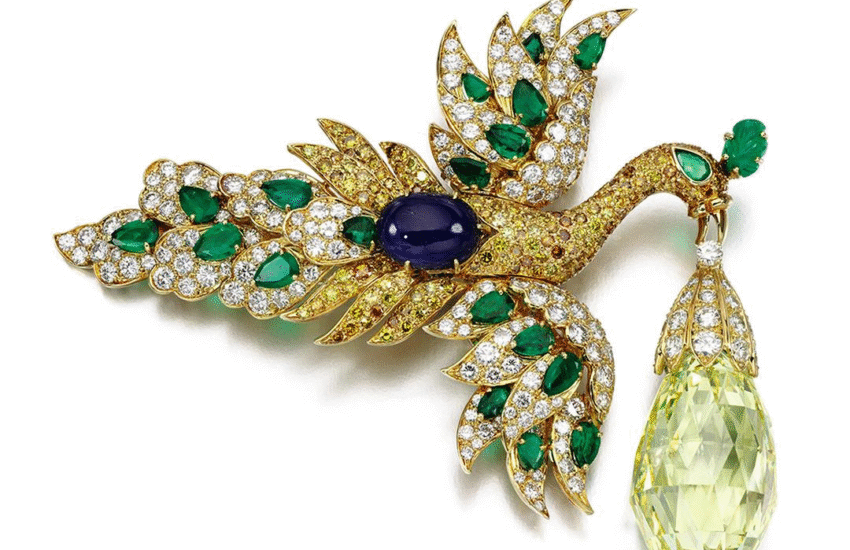Anyone for tennis (jewellery)?
Like strawberries and cream, tennis and jewellery have long been partners. The classic diamond tennis bracelet might be the piece of jewellery which springs to mind first, but tennis has inspired jewellers since the late nineteenth century. Lawn tennis developed from real tennis, its earlier indoor, men-only cousin, to become a key part of middle class social life. It gave women the opportunity to take part in sport and was the perfect way for young people to meet, socialise and fall in love. Jewellers naturally seized their chance to make tennis themed jewellery to meet this new market.
Racket brooches
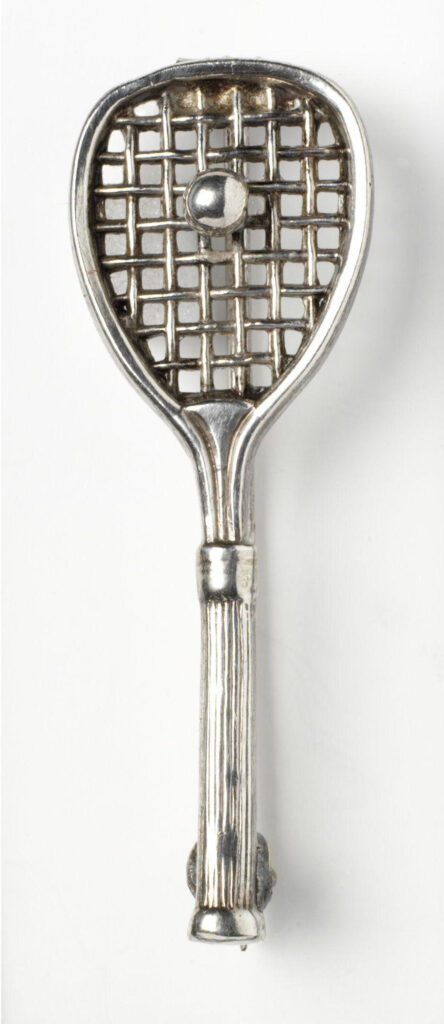
Just as tennis became widely played in the later nineteeth century, brooches shaped like tennis rackets rose in popularity. Cheap silver and white metal versions were turned out by Birmingham jewellery firms, like this electroplated version from around 1880 in the V&A collection. More expensive gold and gem-set versions were also available. An advert in the Croydon Advertiser in 1892 appealed for the return of a ‘small GOLD BROOCH, form of tennis racquet set with pearls’, suggesting that these racket brooches were popular at all price levels. Another advert appealed for a turquoise set racket brooch. Most manufacturing jewellers added tennis to their sporting jewellery offer.

By 1936, the Leeds Mercury put them in their ‘amusing trifles’ column, telling their readers that ‘it is amusing to see the old-fashioned tennis racquet brooch with a ball on top come back in light wood. It is also light in weight, and priced at 2s 11d. A suitable scarf pin, I dare say. ‘ A wooden version would have been a wearable and casual option.
However, a good idea never really goes out of fashion. Hennell of Bond Street’s tennis racket brooch in 1996 was made of 18 carat gold, complete with a tennis ball studded with tiny diamonds. The Wimbledon strawberry in the backdrop creates a picture of summery glamour.
The first tennis bracelets
In 1881, W. Greener and Co. of Birmingham made a silver bracelet for the new tennis enthusiasts. A wide silver band was decorated with a tennis net, ball and racket, flanked by groups of Japanese style flowers. It looks very like the jewel described in the Staffordshire Sentinel, 8 July 1891, introducing ‘a carriage full of girls wearing dainty cotton dresses with demi-sleeves and long, tight-fitting tan coloured gloves of pau de suede [sic], with silver bracelets clasped round their wrists, each bearing on the silver band a neat gold tennis racquet and net, in bold relief with flowers and grasses prettily embossed upon the silver part […] the pretty conceits, which I was told came from a Birmingham manufacturer.’

In the 1990s, Links of London moved into the tennis arena with their bracelet set with silver tennis balls and their racket charms.
Tennis jewels for the sportsman
Men weren’t left out of tennis jewellery. The Fleetwood Chronicle‘s round up of Christmas jewellery in 1893 told their readers that ‘the latest cufflinks have each side of a totally different design; for instance, a jockey cap is combined with a whip, a horse shoe to a hunting crop, a tennis racquet to a ball, all highly appropriate if presented to lovers of the various sports thereof’.

Sporting jewellery continued to be popular into the twentieth century. Hermes’s tennis collection included racket and ball shaped cufflinks for the stylish and sporty man. Tennis cuff-links can currently be bought from Aspinal of London amongst others.
Jewellery prizes for tennis players
Tennis competitions soon became part of the social timetable. Tennis themed jewellery was the perfect prize. The 1893 tournament between the mistresses, old girls and present girls of Worcester High School was celebrated with a tennis racket as the first prize and a brooch shaped like a ‘racquet ball in miniature’ went to the runner up.
Numerous newspapers listed jewellery among the tournament prizes. The winner of the Bellfield Lawn Tennis club’s competition in 1892 received a ‘beautiful gold racquet brooch’. A successful American lawn tennis competitor in County Wexford in 1908 was rewarded with the prize of a ‘very handsome gold bracelet’.
The ‘lady champion’ at the 1914 All England Club Challenge Cup was also competing for a gold bracelet, valued at 5 guineas, a substantial sum of money. The 1885 prizes at Wick Lawn Tennis club included a tennis brooch and silver bracelet presented to Miss Sandison and for her partner, Mr Nicolson, a gold pendant, perhaps for a watch-chain, with a commemorative inscription. The club selected its members by ballot from a selected shortlist.

Racket brooches were also used to reward other services to tennis. In 1900, when the long serving secretary of the Little River Tennis Club in New Zealand left the country, she was presented with a gold brooch in the shape of a tennis racket, suitably inscribed.
Love thirty, love forty

Lawn tennis, associated with lazy summer afternoons and tea on the terrace, allowed young people to get together socially in mixed sex groups. Naturally, love affairs prospered on the tennis court and many newspapers reported the weddings of amateur players. When Isabel Baker married Frederick Porter in Benenden in 1936, they exited the church under an arch of tennis rackets held up by their friends from the tennis club.
The tennis party as romantic opportunity became a cliché in art. However, in George du Maurier’s cartoon from 1897, the papa’s plan to marry off his daughters through tennis parties has backfired badly:
“Oh, papa, we’ve all quite made up our minds never to marry, now we’ve got this beautiful house and garden!
(Papa has taken this beautiful house and garden solely with the view of tempting eligible young men to come and play lawn-tennis, etc., etc.)
Tennis courts, whether in clubs or private gardens, were a forum for casual socialising for both genders, often free from stern parental eyes. Tennis was athletic, but in a manageable form, and socially exclusive.
This article, penned from the 1892 Crieff Hyderopathic spa, gives a fair idea of the atmosphere on the tennis court, where ‘such smartly attired, such elastic, active, athletic maidens, armed with racquets, issue forth for the tennis lawn, attended by youths of all shapes and all sizes, clothed in flannel- not that material which is doled out to old women at Christmas, but beautifully white and soft.[…] Oh, the clever chaff, and the merry jests, amongst those maidens with the racquets and the young men in the flannel and eyeglasses. How I do wish I was young and could handle a racquet!’ Clearly there is more on the agenda than sport!
A little racket shaped brooch or bracelet with tennis motifs was a nice reminder of this world of stimulating matches and gentle flirtations.
Fashions in tennis

Tennis dress gradually evolved from the constricting corsets and long skirts of the Victorian and Edwardian eras into cool, comfortable short tennis dresses and skirts. Dress advice for the tennis girl in The Dundee Evening Telegraph, 27 May 1925 suggested ‘tennis frocks, in soft shades of blue, mauve, green and rose will figure as often as white.‘
Image courtesy of the Victoria and Albert Museum
These costumes could be accessorised with a nice brooch or a simple bracelet, perhaps worn above the elbow, like this Parisian fashion plate from 1923. Although the tennis racket suggests sport, the long flowered dress appears more suitable to the sidelines.
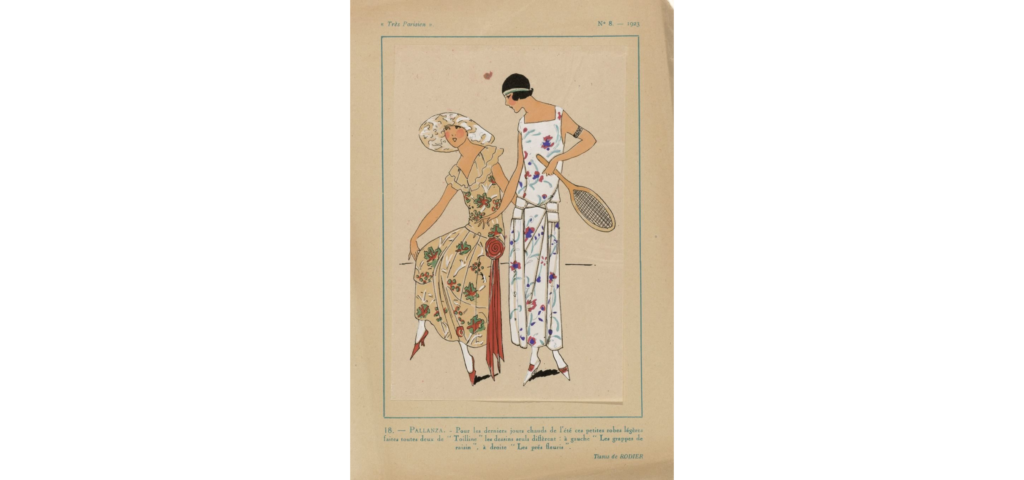
Tennis in the British Empire
Tennis was one of the European inventions which colonists took around the world. Tennis clubs, segretated to exclude local people, were a place for European settlers to exercise and socialise. It allowed players to demonstrate the ideals of fair play and amateurism which they considered part of the colonial project.
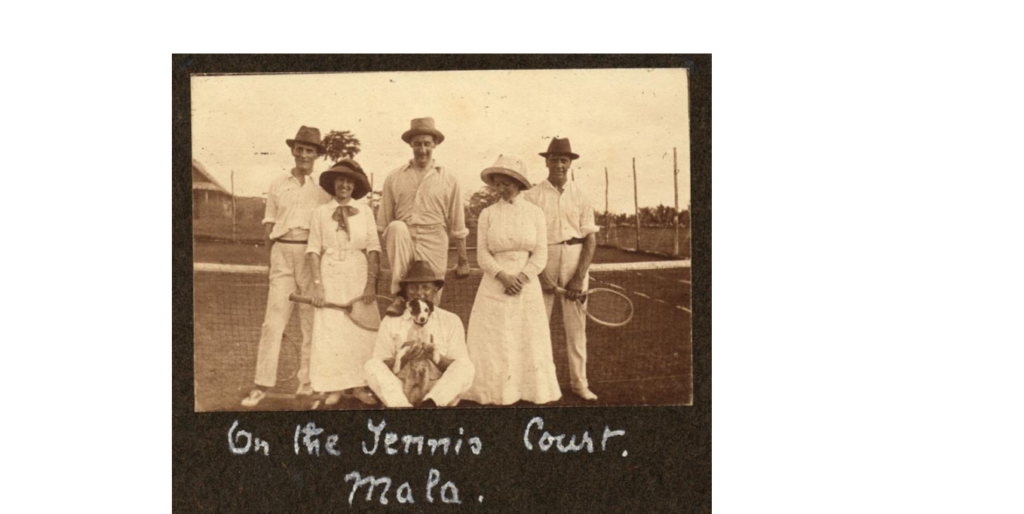
Local newspapers, like the Lahore Civil and Military Gazette, advertised fashionable jewellery for tennis enthusiasts. In 1909, an advert by Max Minck and Co. of Lahore and Simla, included a gold tennis charm bracelet, hung with a pair of shoes, hat, racket and tennis balls, probably imported from Britain.
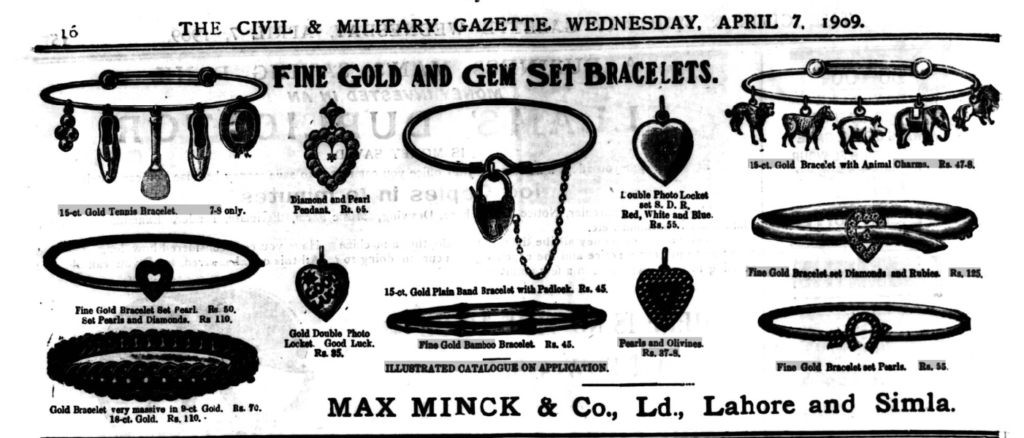
Tennis jewellery was also required for prizes in local competitions. The Tezpur Meet in India in May 1886, reported in the Englishman’s Overland Mail, was a glittering affair, combining horse racing and polo with tennis matches. After dark, a ‘sort of smoking concert was held in the dark bungalow and so the day went on merrily.’ The race bracelet went to the team from Nowgong and the lawn tennis bracelet to Shillong. Maybe these were supplied by Max Minck?
The iconic tennis bracelet
In 1978, the classic diamond line bracelet, popular since the 1920s, became the ‘tennis bracelet’ when it fell from Chris Evert’s wrist, halting play while it was rescued. It’s now part of the image of the modern player, notably Serena Williams’ eye catching Harry Winston diamond bracelet.

Modern tennis players are expected not only to excel at the game but also to project an image of fashionable glamour. The sparkle of a diamond bracelet has become the classic signifier of tennis style.
Further reading
For a very readable insight into tennis: Lake, R. (2014). A Social History of Tennis in Britain. United Kingdom: Taylor & Francis and Pamela Horn, (2011). Pleasures and Pastimes in Victorian Britain. United Kingdom: Amberley Publishing.
More on jewellery social history here with lockets, bridesmaids, scams and fake pearls.
I’ve written more on the tennis bracelet for the British Academy of Jewellery blog.
